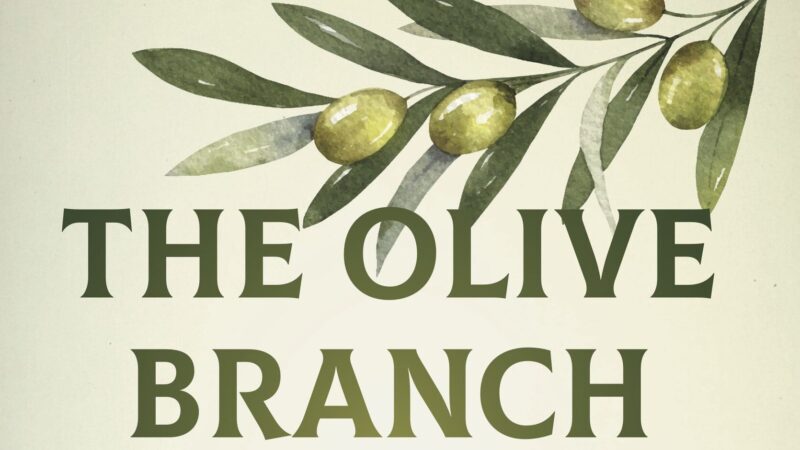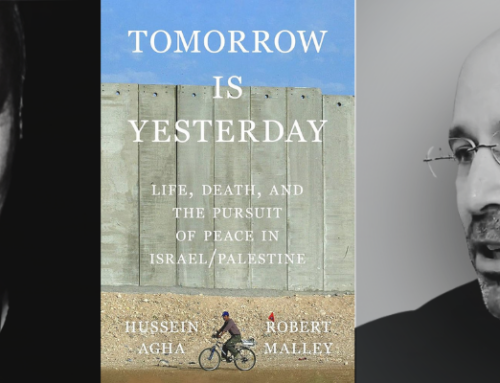The Olive Branch From Palestine:
The Palestinian Declaration of Independence and the Path Out of the Current Impasse
By Jerome M. Segal, (University of California Press, 2022)
Review by Peter Eisenstadt
Another book with a plan to end the Israel-Palestine conflict. Is there a less satisfying genre of reading material anywhere? I have read many, too many. They come in all varieties. Books written by unbowed optimists, books by battle-scarred realists. Tales told by idiots, not worth the paper they are printed on, and books bursting with hard-won insight and wisdom. But however they start, they all have, more or less, the same final chapter, filled with uncertainties, lots of maybes, too many sentences that begin with “perhaps.” I hope the next book of this sort I read has the title, “How I Solved the Israel-Palestinian Conflict.” Reading The Olive Branch From Palestine I was reminded of how a few decades ago there was a big splash when someone finally solved one of perennial unsolved problems of mathematics, Fermat’s Last Theorem. The explanation of the solution was utterly incomprehensible to me, but I was glad that human ingenuity won out over life’s failures and uncompletedness. So I await the day, and may it not be long, when a professor, fresh from her triumph, will explain her solution to the world on a blackboard covered with a series of very long and complex equations, and proclaim: “This is how I solved the Israel-Palestine conflict, quod eratdemonstrandum.”
But until then we will have to make do with excellent books like Jerome M. Segal’s The Olive Branch From Palestine, written by an author who has spent a lifetime troubling and untroubling these treacherous waters. Like all good books of this sort, they remind us, however tempting it might be at times, that cynicism is not an option; it only gives aid and comfort to the enemies of a fair and comprehensive Israel Palestine settlement. This is not only a “how-to-fix-it” book. It is also a gripping first-person history of the creation of the Palestinian Declaration of Independence (PDI), issued on 15 November 1988 by the Palestine Liberation Organization (PLO). Segal played an important role in its gestation.
Now, if, gentle reader, if you, like me, had forgotten whatever little you once knew about the PDI, this book is for you. Segal insists, with much merit, that the PDI is more than an obscure footnote in the dispiriting history of post-1967 efforts to resolve the occupation. Indeed, perhaps the key sentence of the book is “the period from 15 November to December 15, 1988 [the date in which Arafat agreed to American conditions for starting dialogue] represents thirty days of unilateral Palestinian action during which more progress was made toward ending the conflict than in the thirty four years of on-again/off-again negotiations that occurred subsequently.” (xviii–xix). As with many a failed romance, Segal argues that in Israel-Palestine peace efforts, if certain opportunities are missed, they will not come again in a lifetime of moments, and late November 1988 was one of those opportunities. I don’t know if there was enough flexibility in any of the parties at the time to bring about this devoutly to be wished for consummation, but it certainly was an opening that all too quickly closed.
The PDI certainly was issued at a key moment in the conflict, nine months into the First Intifada, which if nothing else, demonstrated to Israel that they did not control the bodies, to say nothing of the hearts and minds, of the Palestinians on the West Bank and Gaza. The intifada was not nonviolent, but neither was it characterized by repeated acts of terrorism against Israelis. In July 1998 King Hussein proclaimed that Jordan no longer claimed sovereignty over East Jerusalem and the West Bank. The PLO, exiled in Tunis since Israel’s 1982 invasion of Lebanon, was eager to return to Palestine. Israel’s habitual hubris, between the fallout from the intifada and the Lebanon invasion, was at a low ebb.
Segal played an important role in getting the PDI drafted, with long editorials in the Palestinian newspaper Al-Quds on the topic, reprinted in the book, and meetings with various Palestinian leaders. The book talks about his activities, but it is not really an autobiography, and I can understand why Segal did not want the book to be more about himself than it already is. But I really wanted to know more about his personal history, and how an American Jew became so close to the Palestinian cause, and what he has been doing for the past 36 years, but that is perhaps the subject of another book. The main drafter of the PDI was the remarkable Palestinian poet Mahmoud Darwish, who was Segal’s friend, and is the book’s dedicatee. If, as in Shelley’s famous words, poets are the unacknowledged legislators of the world, other countries should follow Palestine’s lead and put their best poets to work in polishing the pedestrian prose of their public promulgations.
The main provisions of the PDI were that, for the first time, the Palestinians accepted the 1947 partition plan, which had created a Jewish state and an Arab one, pledged to “join with all states and peoples in order to assure a permanent peace,” and recognized that many different peoples had lived in historic Palestine. And although negotiations were difficult, the PDI had the backing of all the major Palestinian factions, including the militant Popular Front for the Liberation of Palestine. As its drafters expected, Israel’s reaction—Yitzhak Shamir was then prime minister—was entirely dismissive. The United States was opposed to the PDI and to a Palestinian state, and announced three conditions that the Palestinians must meet before starting a dialogue: a willingness to begin negotiations with Israel on the basis of UN resolutions 242 and 338, a declaration that it would live at peace with Israel in the West Bank and Gaza within mutually recognized boundaries, and a commitment to firmly renouncing terrorism. This eventually happened to the satisfaction of the US, but subsequently the US opposed efforts by the PLO to gain non-nation member status at the UN. For their part, Segal criticizes the PLO for not disbanding itself and working towards the creation of a democratic Palestinian state representing all Palestinian factions, and for not unambiguously renouncing violence. His main point is that the Palestinian reliance on negotiations was doomed to fail; instead it should do what Israel did in 1948 declare its independence on its own.
Like all books of this sort, Segal’s is full of counterfactuals. Speculating about “what-if” histories is a good Jewish tradition dating back to, at least, “Dayenu,” and like that song, Segal wonders what “would have been enough” to solve, or at least greatly ameliorate, the Israel Palestine conflict. And Segal suggests that if the Palestinians had held out for statehood and independence, instead of trading that ambition for the mess of pottage offered them at Oslo, a non-sovereign Palestinian Authority, the current situation could have been much better. It certainly could not have been much worse. Because when, after Oslo, the will-o-the wisp of Palestinian sovereignty evaporated, it hardened opinion on all sides, leading to the Second Intifada, an emboldened Hamas, and an equally ascendent hard Israeli right.
At the core of The Olive Branch From Palestine is Segal’s defense of Palestinian unilateralism. It is a paradoxical claim. The best way to end the Israel Palestinian conflict, Segal argues, is not to negotiate, but to assert a non-negotiable claim. He argues that the weaker party in a negotiation, in this case the Palestinians, cannot win at the table what they have not already accomplished on the ground. Instead, the Oslo negotiations merely gave Israel veto power over Palestinian ambitions. For Segal, the best Palestinian option would have been working to create the structures of a functioning and stable Palestinian state, rather than wishing and hoping that somehow their half a loaf will grow into a full loaf. On the other hand, it’s hard to see that Israel ever would have a let a state develop on the West Bank and Gaza after 1988.
To me, Segal’s quest for Palestinian unilateralism sounds very similar to the sort of radical nonviolence advocated by folks like Gandhi, King, and Howard Thurman. The weaker party needs to claim their equality with their oppressors, without asking their approval, and start to implement their plans, which, crucially, must involve getting widespread support and action behind their initiatives. In this way they can create new “facts on the ground.” But the trick, and supreme difficulty of radical nonviolence, is to do this without increasing the fear of the more powerful group that they have lost control of the situation, and must violently suppress it. The basic problem in the Israel Palestine conflict is that any solution that is satisfactory to the Palestinians will decrease Israeli ability to control Palestinian lives , and a majority of Israelis will have to be convinced that rather than weakening themselves, the prospect of a genuine stability actually is a positive gain. And a majority of Palestinians will have to be convinced that whatever compromises this entails will result in a real and not ersatz sovereignty. And the reason why most advocates of radical nonviolence have been religious thinkers is that for this to occur, in any situation, a spiritual rather than a merely political realignment is required. Otherwise, it is likely to be just another roadmap to nowhere.
Segal’s argument is that two states were possible back in the late 1980s. And he believes that two states are possible now, and devotes the last chapter to his plans, and like all such last chapters, it is written, necessarily, in the subjunctive. Some of his ideas are very intriguing. I was particularly taken with his plans for the Palestinian refugee question, where he suggests that between some land swaps including the return of some Palestinians to the sites of their destroyed villages, some return of Palestinians to Israel proper, and an overall cap of half a million returnees might solve things. I was also taken with his ideas for linking the Israel Palestinian conflict to the Israel Iran conflict, and he is surely correct that if the Abraham Accords are merely a way of forging a greater anti-Iranian coalition, nothing will be accomplished.
Is Segal’s plan possible? Two states were definitely possible in 1988. As for 2022, count me as skeptical. I think that two states would be the most stable way forward. But a Palestinian state vivisected by settlements would be the least stable way forward, and I can’t see a serious dislodgement of the settlements in the near future. But I also think that the question is whether a particular peace plan is possible or practical or not is not the most important question. Given the weakness of the Palestinians every peace plan is impractical. It is always easier to make the argument that any way forward, two states, one state, confederation, what have you, is more likely to fail than succeed. Having no good options is a usual consequence of political weakness, and Segal’s point is that when no good options exist, Palestinians just have to, unilaterally, create one. And, I hope, bring with it the spiritual discipline that successful unilateralism requires.
But the greatest virtue of The Olive Branch From Palestine is not Segal’s suggestions for the future but his retrospective analysis of the PDI. Sovereignty is not only a legal and political term, but it is a social and psychological reality. To be a citizen is to have control of one’s life, to know that paths to advancement are not barred, that your participation in civil society is welcome, and that the legal system is responsive to one’s needs for security. What Palestinians long for, above all else, in some arrangement, is real and effective citizenship. I have known, for over half a century, that this will happen. One can look at the last half century of peace efforts as unmitigated failure heaped on unmitigated failure or, as Segal encourages us to do, as a series of near misses and lost opportunities. There are no completely new ideas when it comes to the Israel Palestine conflict. Every possible way out his been proposed at one time or another. I do believe that, as Segal suggests in the subtitle of his book, there is a path out of the current impasse. And we have walked on man y, too many, paths. But Segal encourages us to hope, with the Palestinians in the lead, charting their destiny, that Israel and Palestine can together choose a path, and finish the walk.
___

Peter Eisenstadt is a member of the board of Partners for Progressive Israel and the author of Against the Hounds of Hell: A Biography of Howard Thurman (University of Virginia, 2021).







Leave A Comment